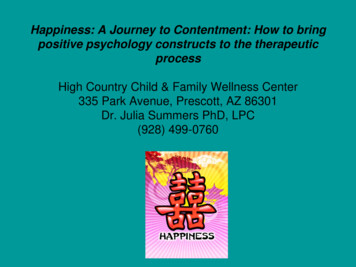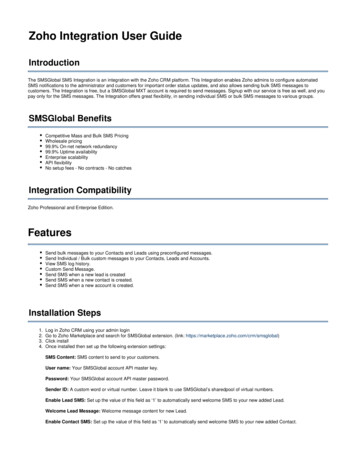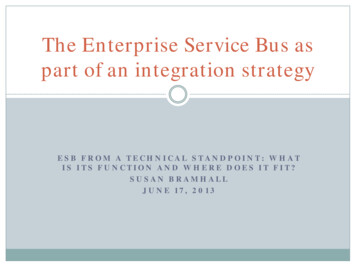
Transcription
VISTAS OnlineVISTAS Online is an innovative publication produced for the AmericanCounseling Association by Dr. Garry R. Walz and Dr. Jeanne C. Bleuerof Counseling Outfitters, LLC. Its purpose is to provide a means ofcapturing the ideas, information and experiences generated by theannual ACA Conference and selected ACA Division Conferences. Paperson a program or practice that has been validated through research orexperience may also be submitted. This digital collection of peer-reviewedarticles is authored by counselors, for counselors. VISTAS Online containsthe full text of over 500 proprietary counseling articles published from2004 to present.VISTAS articles and ACA Digests are located in the ACAOnline Library. To access the ACA Online Library, go tohttp://www.counseling.org/ and scroll down to the LIBRARYtab on the left of the homepage.nUnder the Start Your Search Now box, you may searchby author, title and key words.nThe ACA Online Library is a member’s only benefit.You can join today via the web: counseling.org and viathe phone: 800-347-6647 x222.Vistas is commissioned by and is property of the American CounselingAssociation, 5999 Stevenson Avenue, Alexandria,VA 22304. No part of Vistas may be reproduced without expresspermission of the American Counseling Association.All rights reserved.Join ACA at: http://www.counseling.org/
Suggested APA style reference: Miller, A. M., Sward, J. M., Nielsen, R. C., & Robertson, S. N. (2011).Theoretical integration of humanistic and cognitive/behavioral approaches in counseling. Retrieved fromhttp://counselingoutfitters.com/ vistas/vistas11/Article 51.pdfArticle 51Theoretical Integration of Humanistic and Cognitive/BehavioralApproaches in CounselingAnn M. Miller, Jon M. Sward, Robert C. Nielsen, and Samuel N. RobertsonMiller, Ann M., is an Assistant Professor in the School Counseling Program andthe Director of Community Counseling Services at Emporia State University inEmporia, Kansas. Her professional interests include exploring client experiencesat counselor education program training facilities, and evaluating professionaland ethical standards in counselor education programs and clinical trainingfacilities. amille15@emporia.eduSward, Jon M., is an Assistant Professor in the Mental Health CounselingProgram at Emporia State University in Emporia, Kansas. He is also a licensedattorney and has professional and research interests in legal and ethical issues,brief counseling, wellness, and counseling resistant clients. jsward@emporia.eduNielsen, Robert C., is a Professor in the Counselor Education Program at NorthDakota State University in Fargo, North Dakota. His humanistic foundation wasdeveloped in his doctoral program at the University of Northern Colorado, wherehe graduated in 1972. As a counselor educator, Bob has built upon his humanisticfoundation a structure that also incorporates cognitive/behavioral interventions.robert.nielsen@ndsu.eduRobertson, Samuel N., is a doctoral student at North Dakota State University. Heworks at Crow Creek Tribal School as a Drug and Alcohol Counselor/Teacher inSouth Dakota. He is interested in the Dakota culture as an enrolled member ofthe Sisseton/Wahpeton Tribe (Oyate), and does work in the area of anti-racism.samandliz 50@yahoo.comCounseling involves a process of human interaction that encompasses the client’sthought process, emotional makeup, and behaviors. The degree to which the counselingexperience focuses on these specific aspects of the individual is generally thought to bestrongly influenced by the theoretical orientation of the counselor. Various theories orcounseling approaches have as major components a particular focus on specific aspects ofthe client’s condition and/or functioning. According to Corsini and Wedding (2008),there are over 400 counseling theories that have been identified. Most of theseapproaches would be better labeled as variations on a much smaller number of theoreticalthemes. Hackney and Cormier (2009) placed them into five dominant categories:psychodynamic, cognitive/behavioral, humanistic, transpersonal, and systemicapproaches. Fitch, Canada, and Marshall (2001) stated that their research involving theCouncil for Accreditation of Counseling and Related Educational Programs (CACREP)
Ideas and Research You Can Use: VISTAS 2011accredited counselor training programs indicated that cognitive/behavioral approacheswere most represented in clinical training programs followed closely by humanisticapproaches. Therefore, through the contributions of two dominant categories ofcounseling theory most presented in counselor education programs, this article will focuson the integration of a humanistic counseling approach with a cognitive/behavioralapproach.Two Theoretical ApproachesThere are many different interpretations regarding what constitutes a theory.Dictionaries do not agree on a precise definition of theory, however, the most generallyaccepted definition is that a theory involves what is thought to be true. Theory also seemsto have a predictive element. That is, if this is presented then that will occur. Phemister’s(2001) review of a 1998 text by Corey and Corey stated the following:A theory is understood to be [a] tool that a counselor uses to help organizeinformation into meaningful frameworks that allow him or her to makesense of particular situations and events, to construct definitions, and toidentify potential problems and solutions. (p. 5)According to Hackney and Cormier (2009):Counseling theories can serve a number of functions. They serve as a setof guidelines to explain how human beings learn, change, and develop;they also propose a model for normal human functioning; and they suggestwhat should transpire in the counseling process and what the outcomes ofcounseling could be. In short, a counseling theory offers a “map” of thecounseling process and the route its participants should take to achievecertain goals. (p. 5)Allport (1962) presented two major beliefs about people in general as theyinfluence the work of the counselor. The first is based on determinism, and the second onactualizing. Both humanistic and cognitive/behavioral theories are centered on thesecond. The difference between the two is in the underlying philosophy guiding theirimplementation. Humanistic theories focus on the relationship and the “person skills”displayed by the counselor, such as an inviting attitude conveyed by the counselor alongwith other attitudes including acceptance, honesty, genuineness, and a warmth that theclient can sense. The cognitive/behavioral theories utilize more specific techniques andan educational component within the counseling process that is more focused on aclient’s thought process.Both of these theoretical themes are based on the underlying assumption that freewill is a reality, and that individuals must first look within themselves and then exercisefree will for change to occur. Consistent within classical counseling literature is the linkbetween free will and responsibility (Beck, 1994; Furlong, 1981; May, 1969; Tillich,1952; Yalom, 1980). Responsibility becomes paramount for client change to take place inboth theoretical approaches. May (1967) and Yalom (1980) stated that responsibility canbe defined as response plus ability. For client change to occur, the individual must chooseto respond given his/her ability to do so. Both theoretical approaches mentioned here2
Ideas and Research You Can Use: VISTAS 2011honor the essence of the individual and their ability to change, yet the focus for thecounselor and how the individual may respond and use his/her ability to change differs.Humanistic TheoriesAccording to Nugent (2000), person-centered, Gestalt, and the existential theorymake up the humanistic counseling approaches. Of these, person-centered counseling isthe major focus of the humanistic representation in CACREP accredited counseloreducation programs. “Person-centered counseling dominated the humanistic category,with more tallies than the existential and Gestalt approaches combined” (Fitch et al.,2001, p. 238). Person-centered counseling involves concepts stemming from terms suchas congruence, non-possessive warmth, empathy, and unconditional positive regard. “Theperson-centered theory focuses on the therapeutic relationship in which the therapisthelps the client achieve insight, independence, and development through the client’sinnate drive for growth and wholeness” (Fitch et al., 2001, p. 233). For these results to bemanifested in the client, the client must feel the real or authentic presence of thecounselor who possesses and conveys honest empathy, warmth, and unconditionalpositive regard in the relationship. Mearns (1994) suggested that a counselor “tryconcentrating on being fully present with the client rather than on understanding theclient” (p. 9). This statement is presented as a key point in reference to the core ofperson-centered counseling.A basic premise of the person-centered theory is that change will occur in apositive direction given the environment that will enhance that opportunity. Thecounselor’s role focuses on creating that environment to enhance the client’s potential tomake healthy choices. The center of that environment is manifested more on the affectiverelationship between the counselor and the client than it is on the actual physicalsurroundings of the counseling session.Mearns (1994) also stated, “It is commonly supposed that the person-centeredapproach has no goals for the client beyond that which the client has for himself” (p. ix).He believed that goals are global in nature and through the counseling process the clientwill grow in personal power and ability to make healthy decisions for himself or herself.The counselor seldom, if ever, focuses on specific behavioral goals. Mearns also notedthat, “the person-centered counselor must always remember that he/she is a guest withinthe client’s world of experience” (p. ix).In the humanistic counseling process, typically the effective counselor is authenticin representing who he or she is in the relationship. The client, through the process offeeling validated as an individual, also feels free to share their honest impressions of whothey are and through that process gains true insight into themselves. The choice thenbecomes whether the client wants to accept what the insight has indicated and embracewho they are. The premise is that change cannot occur without initial acceptance. Whenthere is a foundation of trust, honesty, and acceptance in a counseling relationship, thereis a solid base from which to build. The goal is that the client will experience feelings thatwere previously denied to their awareness, then a client can move toward an increasedawareness, spontaneity, trust in self, and inner directedness (Corey, 2009).3
Ideas and Research You Can Use: VISTAS 2011Cognitive/Behavioral TheoriesA basic premise of a cognitive/behavioral theory is that a feeling or emotion is aresult of cognitive processing or thought. This, in turn, can affect behavior. How onethinks about something, including themselves and other people, determines how theyfeel. The person’s perception of reality becomes far more important as an emotional andbehavioral catalyst, than reality itself. New cognitive processing (a change in our thoughtprocess) is therefore very important for emotional and behavioral change to occur.Simply put, thoughts must change in order for feelings and actions to change. If thispremise is accepted, feelings and actions are not automatic, but are a result of cognitiveprocessing either consciously or below the level of actual consciousness.Cognitive/behavioral approaches are generally psychoeducational, which emphasizescounseling as a learning process, including acquiring new ways of thinking, learning andpracticing new skills, and acquiring more effective ways of coping with problems (Corey,2009).A phobia is a fear of something that normally has very little, if any, basis inreality. For an individual to not feel anxious in an enclosed space (claustrophobia), thatindividual will have to think differently about the situation. For example, an individualwho is afraid to ride in an elevator will have to think differently about that experience inorder to not experience a feeling of anxiety. In cognitive/behavioral terms, cognitiverestructuring will have to take place in order for that individual to ride comfortably in anelevator. Cognitive counseling involves the process of cognitive restructuring for theclient. Ivey, D’Andrea, Ivey, and Simek-Morgan (2007) believe that cognitiverestructuring is where the counselor “seeks to change clients’ thinking patterns and wayof constructing their worldviews” (p.208). The counselor assists the client in learningnew reality-based ways of thinking about whatever is triggering their faulty, often anxietygenerating, cognitions.In the example presented above, changing the internal dialogue and how onethinks about riding in an elevator can play a central role in one’s behavior. A clientwilling to accept their fears/beliefs as irrational, may then actually ride in an elevator(often, to repeat successful results), and this will reinforce their new reality-basedthoughts. The thoughts of being relatively safe while riding in an elevator will lead toone’s ability (behavior) to ride in elevators without feeling highly anxious.The importance of cognitive restructuring becomes clear when working withclients with suicidal ideation. In their work involving suicide and cognitive-behavioralcounseling, Carney and Hazler (1998) stated, “Cognitive approaches to conceptualizingsuicide emphasize how thoughts influence emotions and behaviors; individualinterpretation of a situation impacts feelings and actions. These interpretations developinto personal belief systems that guide behaviors and influence perceptions andmemories” (p. 30). Predictors of suicide risk, according to Hughes and Neimeyer (1993),were cognitive perceptions of hopelessness and a negative impression of self. Weishaarand Beck (1992) indicated that suicidal individuals typically have a low concept of self,do not see possibilities of improvement, and see no reason to go on living. Thesecognitions must change in order for the suicidal client to not feel like killing himself orherself.Because a main focus of counselor responsibility in cognitive/behavioralapproaches involves helping clients learn new reality-based ways of thinking about4
Ideas and Research You Can Use: VISTAS 2011whatever is triggering their faulty cognitions and then assisting clients to specify goalsand follow a treatment plan, a fairly directive counseling approach is most oftenemployed. However, a consistent variable in all effective counseling remains the strongrelationship between the client and the counselor.The Integration of Humanistic and Cognitive/Behavioral ApproachesTheoretical approaches are often debated within the counseling profession and thedifferences between them are the main focus of discussion. One theory is pitted againstthe other to show how one theory is better than another, sometimes with a focus on howone theory is better for a given client or a given presenting concern. Commonalities aremore important in accounting for success in counseling than the unique factors thatdifferentiate among them, yet we seldom have conversations centered on the integrationof counseling theories.The integration of multiple techniques and strategies to meet the unique needs ofclients was introduced by Arnold Lazarus’ multimodal approach. Lazarus believed thatclients are troubled by a multitude of specific issues that should be dealt with using abroad range of specific methods. In relation to multimodal counseling, Corsini andWedding (2008) stated, “Clinical effectiveness is predicted on the therapist’s flexibility,versatility, and technical eclecticism” (p. 369). Corey (2009) further explained:Multimodal therapists take great pains to determine precisely whatrelationship and what treatment strategies will work best with each clientand under which particular circumstances. Multimodal therapists areconstantly adjusting their procedures to achieve the client’s goals intherapy. (p. 252)Therefore, the counseling profession has witnessed an increased convergenceamong theorists and a growing realization that no single theory can explain or fit allclient challenges. The result is an emerging view that theory is meant to serve the user,and when no single theory totally fits the counselor’s needs, then a blending ofcompatible theories is an acceptable practice. This is known as an eclectic or integrativeapproach (Hackney & Cormier, 2009).Theoretical integration refers to a conceptual or theoretical creation beyond amere blending of techniques. The goal is to produce a conceptual framework thatsynthesizes the best aspects of two or more theoretical approaches with the assumptionthat the outcome will be better than either theory alone. The emphasis is in integrating theunderlying theories of counseling along with the techniques of each (Corey, 2009). It isbest-characterized by attempts to look beyond and across the confines of a singlecounseling approach to see what can be learned from other perspectives. The majority ofcounselors do not claim allegiance to a particular theory, but prefer some form ofintegration (Norcross, 2005; Norcross & Beutler, 2008). In a survey conducted by thePsychotherapy Networker (2007), only 4.2% of respondents identified themselves asbeing aligned with one counseling approach exclusively. The other respondents, 95.8%,claimed to be integrative, meaning they combined a variety of approaches in theircounseling practice.Motivational interviewing provides another example of the integration oftheoretical approaches. Miller and Rollnick (2002) linked the development of5
Ideas and Research You Can Use: VISTAS 2011motivational interviewing with the Transtheoretical Model (TTM; Prochaska &DiClemente, 1983, 1984; DiClemente & Prochaska, 1985, 1998). In particular the “stagesof change” aspect of TTM has played an integral role in the interventions using amotivational approach. The first stage (pre-contemplation) is characterized by a client’sperception that “there is no problem.” Stage two (contemplation) is characterized byambivalence – “sometimes I think there may be a problem, but I’m really not sure.”Miller and Rollnick found that during the stages of pre-contemplation and contemplation,client-centered and reflective listening counseling skills associated with a humanisticapproach fit better with the needs of clients in those stages.Miller and Rollnick (2002) also found that before people can move into stagethree and four, the preparation and action stages, they must first resolve the ambivalencedominating the contemplation stage. While clients are in the contemplation stage, ifcounselors inadvertently align themselves with one side of an ambivalence issue throughearly arguments intended to convince clients they have a problem -- along with proposedchanges/solutions-- clients find themselves with little choice but to defend the other sideof the ambivalence issue. The end result is that clients get stuck defending the lack of aproblem which tends to produce “resistive clients.” Therefore, it is essential to first meetclients at their understanding of the world and establish rapport, freeing them to draw outand resolve their own ambivalence in favor of a need for change. Even the most highlyskilled counselors cannot resolve ambivalence for their clients. Clients will not be readyto move into change until they have resolved their own ambivalence. After clientsresolve their ambivalence and move into the “preparation stage,” counselors caneffectively shift into using counseling strategies that are more directive -- like thosefound in a cognitive/behavioral approach. Stages three, four, and five -- preparation,action, and maintenance -- can be thought of as that building on top of the foundation inour metaphor.Counseling skills associated with cognitive/behavioral approaches are usuallymore directive, while humanistic approaches are generally non-directive. Non-directiveskills can be relationship enhancing as the counselor’s goal is to empower the client tolead and guide their own personal growth; whereas directive skills assist the counselorand client to focus on specific problem-solving processes, such as cognitivelyrestructuring a client’s faulty perceptions/irrational beliefs. Integrating these twotheoretical approaches by implementing both directive and non-directive skills mayenhance the development of a healthy counseling relationship, as well as focus onspecific immediate change for the client.An analogy can be visualized involving the construction of an actual physicalstructure; a home or office building, for example. A solid foundation is necessary tosupply a solid base for the structure to be built upon. Without a firm foundation, thestructure will crumble. Carrying the analogy further, imagine the foundation ascomponents of humanistic counseling that have the potential to strengthen therelationship between the counselor and client. Utilizing a humanistic approach, the clientwill be able to build his or her own house, given the strength of the counselingrelationship. The counselor’s role is to be with, listen, encourage, and support the clientin the process. Given the same foundation (client-counselor relationship), the cognitive/behavioral counselor takes a more directive role in helping the client see how to makechanges involving the construction of the house by pointing out faulty perceptions and6
Ideas and Research You Can Use: VISTAS 2011“reality checking” with the client to see how one aspect of the construction affects theentire house. The cognitive/behavioral counselor goes beyond that and suggests to theclient possible ways to change their thinking (cognitive restructuring) in order to build abetter house.ConclusionCounselors traditionally operated from within their own theoretical frameworks,often to the point of ignoring alternative conceptualizations and potentially superiorinterventions. No single theory is comprehensive enough to account for the complexitiesof human behavior, especially when the range of client types and their specific problemsare taken into consideration (Corey, 2009; Hackney & Cormier, 2009). Because no onetheory contains all the truth, and because no single set of counseling techniques is alwayseffective in working with diverse client populations, integrative approaches hold promisefor counseling practice. Norcross and Beutler (2008) maintain that effective clinicalpractice requires a flexible and integrative perspective: “Psychotherapy should be flexiblytailored to the unique needs and contexts of the individual client, not universally appliedas one-size-fits-all” (p. 485). Brooks-Harris (2008) stated, “Psychotherapy should beintentional, multidimensional, multitheoretical, strategy-based, and relational” (p. 40).Blending the conceptual framework of a humanistic approach with the techniquesof a cognitive/behavioral approach, the skillful counselor may be better equipped to helpa variety of client problems. Building a strong therapeutic relationship with a clientthrough genuineness, warmth, empathy, and unconditional positive regard (humanisticapproach), while helping clients restructure their thoughts and modify respondingbehavior (cognitive/behavioral approach), may accelerate client change. We mustrecognize the contributions of pure-form therapies and collaboratively enlist theirrespective strengths (Norcross & Beutler, 2008). It is proposed that humanisticcounseling approaches and cognitive/behavioral counseling approaches do not need tohave opposing views; rather, when skillfully integrated, they can complement oneanother and enhance the efficacy and applicability of counseling.ReferencesAllport, G. (1962). Psychological models for guidance. Harvard Educational Review, 32,373-381.Beck, R. (1994). Encouragement as a vehicle to empowerment in counseling: Anexistential perspective. Journal of Rehabilitation, 60, 6-11.Brooks-Harris, J. (2008). Integrative multitheoretical psychotherapy. Boston, MA:Lahaska Press.Carney, J., & Hazler, R. (1998). Suicide and cognitive-behavioral counseling:Implications for mental health counselors. Journal of Mental Health Counseling,20(1), 30-34.Corey, G. (2009). Theory and practice of counseling and psychotherapy (8th ed.).Belmont, CA: Brooks/Cole.7
Ideas and Research You Can Use: VISTAS 2011Corsini, R., & Wedding, D. (Eds.). (2008). Current psychotherapies (8th ed.). Belmont,CA: Brooks/Cole.DiClemente, C., & Prochaska, J. (1985). Processes and stages of change: Coping andcompetence in smoking behavior change. In S. Shiffman & T. Wills (Eds.),Coping and substance abuse (pp. 319-342). New York, NY: Academic Press.DiClemente, C., & Prochaska, J. (1998). Toward a comprehensive, transtheoretical modelof change: Stages of change and addictive behaviors. In W. Miller and N. Heather(Eds.), Treating addictive behaviors (2nd ed., pp. 3-24). New York, NY: PlenumPress.Fitch, J., Canada, R., & Marshall, L. (2001). The exposure of counseling practicumstudents to humanistic counseling theories: A survey of CACREP programs.Journal for Humanistic Counseling, Education & Development, 40(2), 232-238.Furlong, F. W. (1981). Determinism and free will: Review of the literature. AmericanJournal of Psychiatry, 138, 435-439.Hackney, H., & Cormier, S. (2009). The professional counselor: A process guide tohelping (6th ed.). Upper Saddle River, NJ: Pearson.Hughes, S., & Neimeyer, R. (1993). Cognitive predictors of suicide risk amonghospitalized psychiatric patients: A perspective study. Death Studies, 17, 103-124.Ivey, A., D’Andrea, M., Ivey, M., & Simek-Morgan, L. (2007). Theories of counselingand psychotherapy: A multicultural perspective (6th ed.). Boston, MA: Pearson.May, R. (1967). The art of counseling. New York, NY: Abingdon Press.May, R. (1969). Love and will. New York, NY: Dell.Mearns, D. (1994). Developing person-centered counseling. London: Sage.Miller, W., & Rollnick, S. (2002). Motivational interviewing: Preparing people forchange (2nd ed.). New York, NY: The Guilford Press.Norcross, J. (2005). A primer on psychotherapy integration. In J. Norcross & M.Goldfried (Eds.), Handbook of psychotherapy integration (2nd ed., pp. 3-23).New York, NY: Oxford University Press.Norcross, J., & Beutler, L. (2008). Integrative psychotherapies. In R. Corsini & D.Wedding (Eds.), Current psychotherapies (8th ed., pp. 481-511). Belmont, CA:Brooks/Cole.Nugent, F. (2000). Introduction to the profession of counseling (3rd ed.). Upper SaddleRiver, NJ: Prentice-Hall.Phemister, A. (2001). Revisiting the principles of free will and determinism: Exploringconceptions of disability and counseling theory. Journal of Rehabilitation, 69(3),5-10.Prochaska, J., & DiClemente, C. (1983). Stages and process of self-change of smoking:Toward an integrative model of change. Journal of Consulting and ClinicalPsychology, 51, 390-395.Prochaska, J., & DiClemente, C. (1984). The transtheoretical approach: Crossing thetraditional boundaries of therapy. Malabar, FL: Krieger.Rogers, C., Minuchin, S., Satir, V., Bowen, M., & Gottman, J. (2007, March/April). Thetop 10: The most influential therapists of the past quarter-century. PsychotherapyNetworker, 31(2), 24-68.8
Ideas and Research You Can Use: VISTAS 2011Tillich, P. (1952). The courage to be. New Haven, CT: Yale University Press.Weishaar, M., & Beck, A. (1992). Hopelessness and suicide. International Review ofPsychiatry, 4, 177-184.Yalom, I. (1980). Existential psychotherapy. New York, NY: Basic Books.Note: This paper is part of the annual VISTAS project sponsored by the American Counseling Association.Find more information on the project at: http://counselingoutfitters.com/vistas/VISTAS Home.htm9
Cognitive/Behavioral Theories A basic premise of a cognitive/behavioral theory is that a feeling or emotion is a result of cognitive processing or thought. This, in turn, can affect behavior. How one thinks about something, including themselves and other people, determines how they feel.










